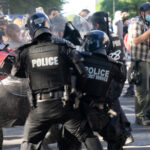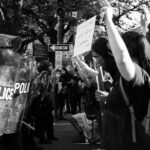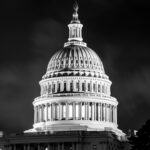Policing’s Historical Roots
Like many established institutions in the United States, policing has been shaped by systemic racism. Historically, policing in the US was created to control those deemed socially marginal (APHA, 2018). Policing originated for purposes such as slave patrols and ruling-class efforts to control working-class immigrants (APHA, 2018). In the reconstructionist era following the abolition of slavery, slave patrols were replaced with police officers who enforced “Black Codes” and vagrancy laws (Cooper, 2015). These laws made offenses such as unemployment and vagrancy illegal and were selectively applied to Black people to establish a system of forced labor through prison labor contracts (Alexander & West, 2012; Cooper, 2015; Benns, 2015). In the aftermath of slavery, states and localities used policing to criminalize circumstances like vagrancy and unemployment among Black people during the reconstructionist period, and policing upheld a racial caste system, systematically blocking Black people and other people of color from social and economic success. Historical policing normalized the criminalization of people of color and positioned police violence as an acceptable method of social control.
Proactive Policing Practices
Today, many aggressive police tactics, such as proactive policing and excessive use-of-force, are disproportionately used with Black people and other communities of color. Proactive policing policies are strategies that deploy law enforcement in high-crime areas to engage directly with civilians to “detect imminent criminal activity or disrupt circumstances interpreted as indicia that crime is afoot” (Geller et al., 2014, p. 2321). Tactics such as Terry stops, commonly known as stop-and-frisk, constitutionally allow police officers to temporarily detain and search anyone they suspect is or will be engaged in criminal activity (Geller et al., 2014). These policies legalize police violations of the Fourth Amendment, which would otherwise protect civilians from unreasonable search and seizure of their persons, houses, papers, and effects by the government (The 4th Amendment of the U.S. Constitution, n.d.). The Terry laws are allowable under the caveat of reasonable suspicion; however, as with the use of force policies, there is minimal guidance on what constitutes reasonable suspicion (Cooper, 2015). The burden of these stop-and-frisk proactive policing policies disproportionately falls upon Black and Latinx individuals (Bandes et al., 2019). A Los Angeles analysis found that Black and Latinx individuals were more likely to be stopped and searched by police but less likely to have contraband than white individuals (Chang & Poston, 2019a).
Proactive policing policies are alarming when considering how ineffective they are. A study of the stop-and-frisk tactic in New York City found that between 2002 and 2014, five million residents were stopped and frisked, but at any given time, between 82% and 90% had committed no offense (Cooper, 2015). These stop-and-frisk encounters were not harmless; the experiences left study participants feeling unsafe in the streets and public spaces of their neighborhoods (Cooper, 2015). Another study of stop-and-frisk practices in New York City found that regardless of age, gender, and reason for being stopped, Black residents were more likely to be pushed into walls or to the ground, handcuffed, have a weapon pointed at them, and to be pepper sprayed or hit by a baton than white residents (Motley & Joe, 2018). These stop-and-frisk encounters can also increase the risk of exposure to physical and sexual violence perpetrated by police officers (H. L. Cooper, 2015). Living in neighborhoods where police employ aggressive stop-and-frisk tactics is associated with adverse health outcomes for Black and Latinx residents (Bowleg et al., 2020).
More on Predictive Policing:
- Predictive Policing: The Role of Crime Forecasting in Law Enforcement Operations – RAND Safety and Justice Program
- Predictive policing algorithms are racist. They need to be dismantled. – MIT Technology Review
- Predictive Policing Explained – Brennan Center for Justice
- Alexander, M, West, C. (2012). The new Jim Crow: Mass incarceration in the age of colorblindness (Revised edition). New Press.
- American Public Health Association. (2018). Addressing Law Enforcement Violence as a Public Health Issue [Policy Report]. https://www.apha.org/policies-and-advocacy/public-health-policy-statements/policy-database/2019/01/29/law-enforcement-violence
- Bandes, S. A., Pryor, M., Kerrison, E. M., & Goff, P. A. (2019). The mismeasure of Terry stops: Assessing the psychological and emotional harms of stop and frisk to individuals and communities. Beh Sci Law 37(2):176-194. doi: 10.1002/bsl.2401 https://pubmed.ncbi.nlm.nih.gov/30912171/
- Benns W. (2015) American Slavery, Reinvented. The Atlantic. https://www.theatlantic.com/business/archive/2015/09/prison-labor-in-america/406177/ accessed August 16, 2023.
- Bowleg, L., Maria del Río-González, A., Mbaba, M., Boone, C. A., & Holt, S. L. (2020). Negative Police Encounters and Police Avoidance as Pathways to Depressive Symptoms Among US Black Men, 2015–2016. American Journal of Public Health, 110 (Suppl 1), S160–S166. https://doi.org/10.2105/AJPH.2019.305460
- Chang, C., Poston, B. (2019a, October 8). LAPD searches blacks and Latinos more. But they’re less likely to have contraband than whites. Los Angeles Times. https://www.latimes.com/local/lanow/la-me-lapd-searches-20190605-story.html
- Cooper, H. L. (2015). War on Drugs Policing and Police Brutality. Substance Use & Misuse, 50(8–9), 1188–1194. https://doi.org/10.3109/10826084.2015.1007669
- Geller, A., Fagan, J., Tyler, T., & Link, B. G. (2014). Aggressive Policing and the Mental Health of Young Urban Men. American Journal of Public Health, 104(12), 2321–2327. https://doi.org/10.2105/AJPH.2014.302046
- Motley RO, Joe S. (2018). Police Use of Force by Ethnicity, Sex, and Socioeconomic Class. J Soc Social Work Res 9(1):49-67. doi: 10.1086/696355.



